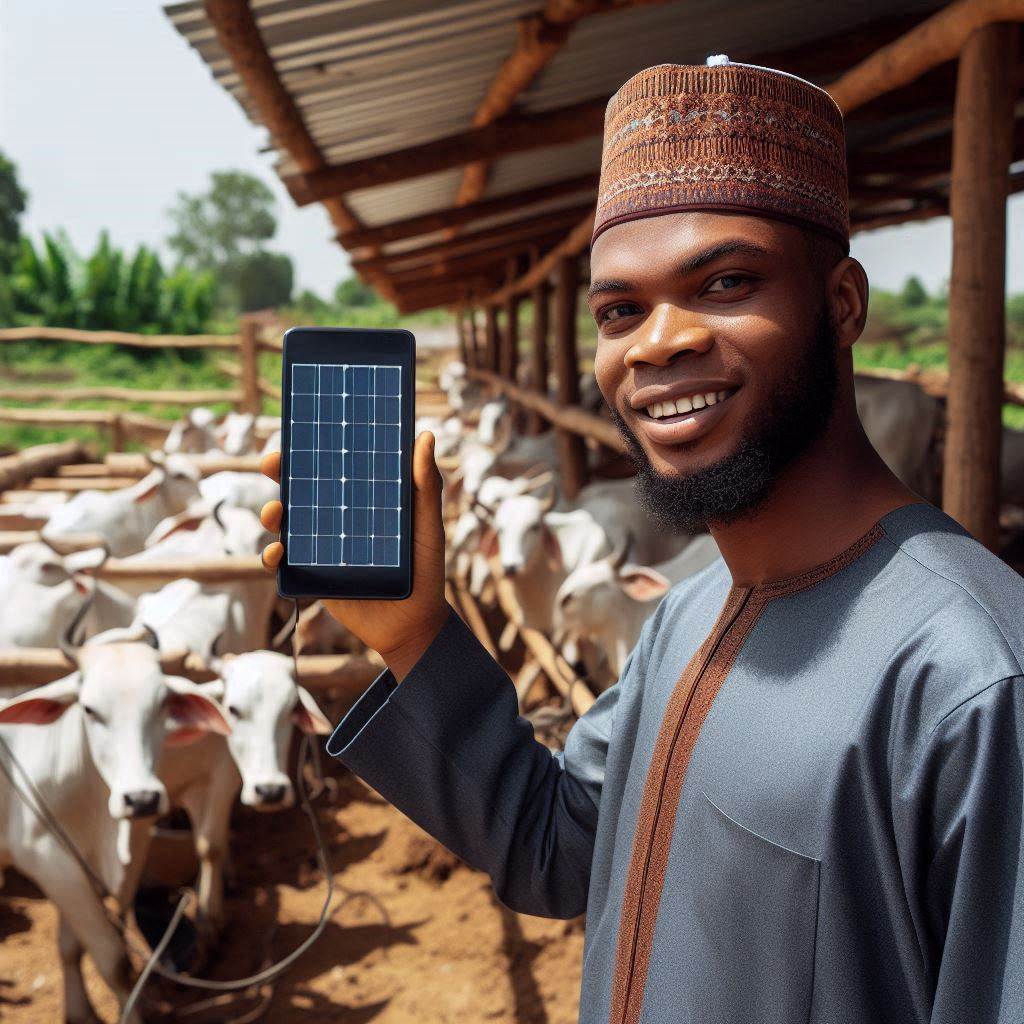Introduction
Welcome to the dawn of a sustainable farming revolution! Solar energy, derived from the inexhaustible power of the sun, stands as a beacon of renewable energy solutions.
Its significance in livestock production cannot be overstated.
Harnessing solar energy in this sector not only marks a shift towards environmental stewardship but also promises substantial benefits.
By tapping into solar power, farmers reduce their reliance on non-renewable energy sources, thereby curbing greenhouse gas emissions and mitigating climate change impacts.
The integration of solar-powered systems in livestock facilities offers multifaceted advantages.
From providing electricity for lighting, heating, and ventilation to powering water pumping systems, solar energy facilitates a more efficient and cost-effective operation.
Additionally, it enhances the resilience of farms against power outages, ensuring uninterrupted operations.
Embracing solar energy in livestock production underscores a commitment to sustainability while simultaneously enhancing profitability.
Join us as we delve deeper into the transformative potential of solar energy in revolutionizing livestock farming practices.
Benefits of Using Solar Energy in Livestock Production
When it comes to using solar energy in livestock production, there are numerous benefits that can be realized. In this section, we will explore some of the key advantages of incorporating solar energy into agricultural practices.
Reduced Energy Costs
- By harnessing the power of the sun, farmers can significantly reduce their electricity bills.
- Solar panels require minimal maintenance and have a long lifespan, making them a cost-effective energy solution.
- With advancements in solar technology, the initial investment in solar panels can often be recouped in a relatively short period.
- For livestock producers, reducing energy costs can lead to increased profitability and overall financial sustainability.
Environmental Sustainability
- Using solar energy in livestock production is a clean and renewable energy source, which helps reduce greenhouse gas emissions.
- By decreasing reliance on fossil fuels, farmers can play a role in combating climate change and promoting environmental stewardship.
- Solar energy systems have minimal impact on the surrounding ecosystem, making them a sustainable choice for agricultural operations.
- Protecting the environment is not only beneficial for future generations but also for the health and well-being of the livestock.
Increased Independence from the Grid
- With solar energy, farmers can operate independently from the grid, reducing the risk of power outages and interruptions.
- During times of extreme weather or natural disasters, solar energy systems can provide a reliable source of power for livestock operations.
- Having backup power through solar energy can be crucial for maintaining the health and safety of livestock in challenging conditions.
- Solar panels can provide a consistent source of energy, allowing farmers to have greater control over their operations and production schedules.
In essence, the benefits of using solar energy in livestock production are undeniable. From reduced energy costs to environmental sustainability and increased independence from the grid, solar energy offers numerous advantages for farmers.
By embracing solar technology, agricultural producers can improve their efficiency, profitability, and overall resilience in an ever-changing climate.
Read: Forestry and Climate Change: Nigeria’s Response and Education
Solar-Powered Equipment for Livestock Production
Harnessing the Sun: Revolutionizing Livestock Production
Unlocking the Potential of Solar-Powered Equipment
Innovations in renewable energy are transforming traditional agricultural practices. Solar energy, in particular, holds immense promise for enhancing efficiency and sustainability in livestock production.
Solar-Powered Water Pumps
- Efficient Water Management: Solar-powered water pumps offer a sustainable solution for ensuring adequate hydration for livestock.
- Off-Grid Capability: These pumps function independently of the grid, providing reliability in remote areas.
- Cost-Effective: By harnessing sunlight, farmers can significantly reduce operational costs associated with pumping water.
- Environmentally Friendly: Solar pumps produce clean energy, minimizing carbon footprint and environmental impact.
- Long-Term Investment: Initial setup costs are offset by long-term savings on electricity bills and maintenance.
Electric Fencing
- Enhanced Security: Solar-powered electric fencing provides a reliable deterrent against predators and unauthorized entry.
- Flexibility: With no reliance on grid power, farmers can install fences in any location, even in remote areas.
- Low Maintenance: These systems require minimal upkeep, reducing labor and operational costs.
- Customization: Farmers can adjust voltage levels to suit different livestock and terrain requirements.
- Scalability: Easy expansion and modification make solar electric fencing ideal for evolving farm needs.
Solar-Powered Lighting Systems for Barns
- Improved Visibility: Solar-powered lighting ensures optimal conditions for livestock care and monitoring.
- Energy-Efficient: LED lighting paired with solar panels maximizes energy efficiency, reducing overall consumption.
- 24/7 Operation: Stored solar energy enables continuous lighting, enhancing productivity and safety.
- Remote Monitoring: Some systems offer remote monitoring capabilities, allowing farmers to track energy usage and system performance.
- Emergency Preparedness: Solar lighting ensures essential areas remain illuminated during power outages.
Solar-powered equipment represents a paradigm shift in livestock production, offering sustainable solutions that benefit both farmers and the environment.
By harnessing the power of the sun, farmers can enhance efficiency, reduce costs, and promote environmental stewardship. As the agricultural sector continues to evolve, embracing solar energy is crucial for building a resilient and sustainable future.
Read: Sustainable Forestry Practices: How Nigeria’s Universities Teach It
Case Studies of Successful Implementation
Sunshine Valley Farm in California
Sunshine Valley Farm in California has integrated solar panels to power their poultry houses and irrigation systems. They have significantly reduced their electricity bills and reliance on the grid.
Lone Star Ranch in Texas
Lone Star Ranch in Texas installed a solar-powered water pump for their livestock. This has ensured a consistent water supply while reducing operational costs and environmental impact.
Prairie Horizons Farm in Iowa
Prairie Horizons Farm in Iowa utilizes solar energy to power their automated feeding systems for cattle. This has improved efficiency, reduced labor costs, and enhanced animal welfare.
Positive Outcomes and Benefits Experienced by These Farms
- Cost Savings: The farms have experienced significant cost savings on electricity bills by harnessing solar energy for their operations.
- Environmental Impact: By reducing reliance on traditional energy sources, these farms have lowered their carbon footprint and contributed to sustainability.
- Operational Efficiency: Solar-powered systems have improved operational efficiency, leading to better productivity and streamlined processes.
- Reliability: Solar energy provides a reliable source of power, ensuring continuous operation of essential equipment on the farms.
- Long-Term Investment: Investing in solar energy systems has proven to be a wise long-term investment for these farms, with reduced maintenance costs and increased property value.
- Community Engagement: These farms have gained positive recognition in their communities for their commitment to renewable energy and environmental stewardship.
Read: Career Prospects in Forestry: Opportunities in Nigeria & Beyond

Challenges and Solutions
Initial costs of solar equipment
Investing in solar equipment can be expensive for livestock producers, especially those operating on a tight budget. The upfront costs of purchasing solar panels, inverters, and batteries can deter some farmers from transitioning to solar energy.
Maintenance and repair of solar panels
Another challenge is the maintenance and repair of solar panels. Dust, debris, and weather conditions can affect the efficiency of solar panels over time, requiring regular cleaning and occasional repairs. This ongoing maintenance can be time-consuming and costly.
Strategies for overcoming these challenges
To overcome the challenges of the initial costs of solar equipment and maintenance of solar panels, livestock producers can implement the following strategies:
Government incentives and grants
Research government incentives and grants available for renewable energy projects in agriculture. These programs can help offset the initial costs of purchasing solar equipment.
Leasing or financing options
Livestock producers can explore leasing or financing options for solar equipment. This allows farmers to spread out the costs over time and make more manageable payments.
Collaboration with other farmers
Livestock producers can also consider collaborating with other farmers in the area to share the costs of installing and maintaining solar panels. This cooperative approach can reduce individual financial burdens and make solar energy more accessible.
Investing in high-quality equipment
Choosing high-quality solar equipment can help minimize maintenance and repair costs in the long run. While the initial investment may be higher, durable and efficient equipment can provide better returns over time.
Training and Education
Providing training and education to farmworkers on the proper maintenance of solar panels can help prolong their lifespan and maximize their efficiency. Regular inspections and cleaning routines can prevent costly repairs in the future.
Monitoring and optimizing energy use
Implementing energy monitoring systems can help livestock producers track their energy consumption and identify areas for improvement. By optimizing energy use, farmers can reduce overall costs and maximize the benefits of solar energy.
Read: Comparing Forestry Curriculum: Nigeria vs. Global Standards
Conclusion
In summary, the integration of solar energy into livestock production brings multifaceted benefits.
It not only reduces operational costs but also minimizes the environmental footprint associated with traditional energy sources.
Solar-powered systems offer farms a reliable and sustainable energy solution, ensuring uninterrupted power supply for various operations.
By harnessing solar energy, farms can enhance their efficiency, productivity, and overall sustainability.
Furthermore, the adoption of solar energy aligns with the global trend towards renewable energy sources, contributing to mitigating climate change effects.
Encouraging more farms to embrace solar energy practices holds the promise of a greener and more resilient agricultural sector.
It empowers farms to become more self-sufficient while reducing reliance on non-renewable resources.
Therefore, it is imperative for farms to seriously consider integrating solar energy systems into their operations.
Embracing solar technology not only benefits individual farms but also contributes to the collective effort towards a more sustainable and environmentally friendly future in livestock production.




